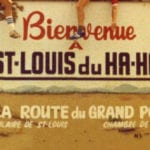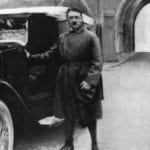 Mysteries
Mysteries  Mysteries
Mysteries  History
History 10 Surprising Stories About the Texas Rangers
 Humans
Humans 10 Philosophers Who Were Driven Mad by Their Own Theories
 Miscellaneous
Miscellaneous 10 Video-Game-Worthy Weapons and Armors from History
 Weird Stuff
Weird Stuff 10 Psychics Who Accurately Predicted Wartime Events
 The Arts
The Arts 10 Pieces of Art Inspired by a Broken Heart
 Health
Health 10 Science Fiction-Sounding New Medical Treatments
 History
History 10 Surprising Facts About the Father of Submarine Warfare
 Space
Space Ten Astonishing New Insights into Alien Worlds
 Weird Stuff
Weird Stuff 10 Bizarre Summer Solstice Rituals Still Practiced Today
 Mysteries
Mysteries Top 10 Haunting Facts About the Ghost Ship MV Alta
 History
History 10 Surprising Stories About the Texas Rangers
 Humans
Humans 10 Philosophers Who Were Driven Mad by Their Own Theories
Who's Behind Listverse?

Jamie Frater
Head Editor
Jamie founded Listverse due to an insatiable desire to share fascinating, obscure, and bizarre facts. He has been a guest speaker on numerous national radio and television stations and is a five time published author.
More About Us Miscellaneous
Miscellaneous 10 Video-Game-Worthy Weapons and Armors from History
 Weird Stuff
Weird Stuff 10 Psychics Who Accurately Predicted Wartime Events
 The Arts
The Arts 10 Pieces of Art Inspired by a Broken Heart
 Health
Health 10 Science Fiction-Sounding New Medical Treatments
 History
History 10 Surprising Facts About the Father of Submarine Warfare
 Space
Space Ten Astonishing New Insights into Alien Worlds
 Weird Stuff
Weird Stuff 10 Bizarre Summer Solstice Rituals Still Practiced Today
10 Stories Behind Incredible Pulitzer Prize–Winning Photographs
They say a picture is worth a thousand words, but for some lucky and daring photographers, that picture can be worth $15,000 and some serious notoriety. The Pulitzer Prize for photography has existed in various forms since 1942, and the award has been given to photographers of some of the most important images ever recorded.
While most pictures tell a tale, the ones chosen for the award often have stories of their own that explain why or how the image was taken. These 10 stand above the rest as some of the most important Pulitzer Prize–winning pictures ever taken. (The year of the award appears below the title or description of the photo.)
10 Firing Squad In Iran
1980
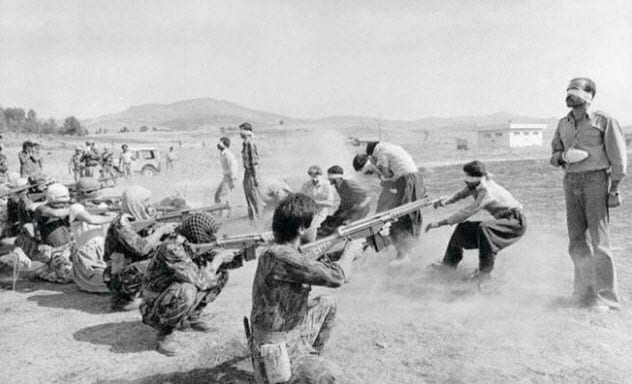
Jahangir Razmi’s provocative photograph, Firing Squad in Iran, won the Pulitzer Prize in 1980, but Razmi didn’t receive the credit he deserved until 2006. The picture was taken on August 27, 1979, but it was published anonymously in the Iranian daily newspaper Ettela’at. Razmi was the only photographer to receive a Pulitzer Prize anonymously, but he had good reason to keep his name out of the papers alongside his intense photograph.
The picture captures the moment when a group of Kurdish militants were executed at the Sanandaj airport. Eleven prisoners were charged with firearm trafficking, inciting riots, and murder in a 30-minute trial. Their execution was carried out immediately afterward.
Razmi followed the condemned men outside where they were quickly put in place for execution. His picture captured a moment when some in the firing squad had fired and some hadn’t. Razmi’s name was protected by the publisher to ensure the photographer’s safety from government reprisal. In 2006, Razmi finally revealed that he was the photographer in an interview with The Wall Street Journal.[1]
9 Fire Escape Collapse
1976
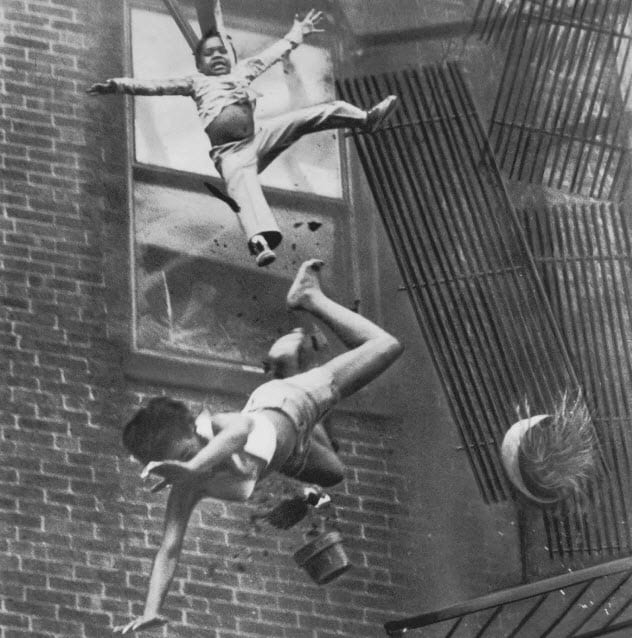
The 1976 Pulitzer Prize for Spot News Photography went to Stanley Forman for his picture titled Fire Escape Collapse. Forman captured the moment when a woman and a child fell from a collapsed fire escape in Boston on July 22, 1975. The two victims were 19-year-old Diana Bryant and her goddaughter, two-year-old Tiare Jones.
Bryant died as a result of the collapse, which occurred when a turntable ladder on a fire engine was being extended to save them at a height of approximately 15 meters (50 ft). Miraculously, Jones was saved when she landed on Bryant’s body.
When Forman arrived on the scene, he put himself in a position where he could capture what appeared to be the start of a daring rescue. Firefighter Bob O’Neil was in the process of reaching Bryant and Jones when the fire escape suddenly gave way beneath them.
Forman continued to shoot the images as the fall took place but realized that he “didn’t want to see them hit the ground.” So he turned away at the last moment. The photograph was also recognized as the World Press Photo of the Year.[2]
8 The Murder Of Heather Heyer
2018
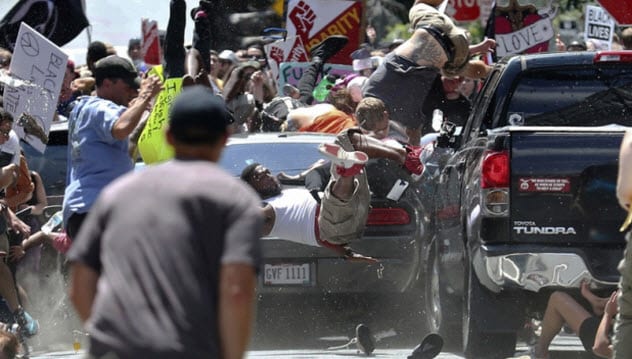
In 2017, Ryan Kelly was working his final day at The Daily Progress in Charlottesville, Virginia. On that day, a protest was carried out in the city over plans to remove a statue of Confederate General Robert E. Lee.
During the demonstration, a man who had ties to a white supremacist movement drove his car into a group of counterprotesters. That attack led to the death of Heather Heyer. It also won Kelly the Pulitzer Prize for Breaking News Photography in 2018 for his untitled photograph showing the moment when Heyer and around 35 others were struck.[3]
After heading outside, Kelly began taking long-shot photographs of the march. But as soon as a car began to barrel down the road, the journalist in him kicked in and he captured the moment that led to Heyer’s death.
The picture became emblematic of the demonstrations taking place across the country and the racial tensions spreading throughout. Kelly had already accepted a new position as the social media manager for a local brewery but opted to remain in the office to help out in case the Unite The Right rally got out of hand.
7 Lone Jewish Woman
2007
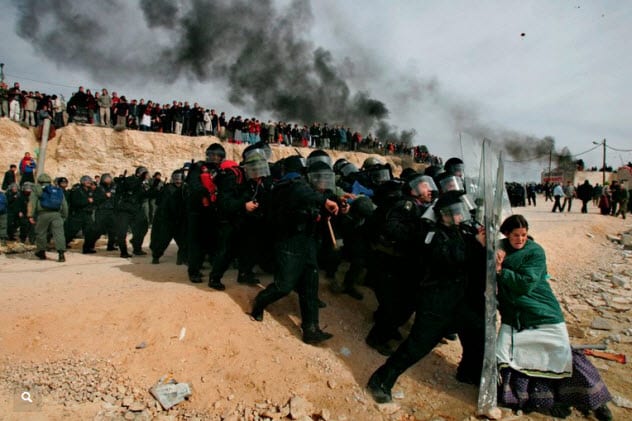
Oded Balilty was working for the Associated Press when he was told to photograph a group of Jewish settlers protesting against Israeli security forces in the West Bank. The picture was taken on February 1, 2006, and Balilty was later chosen as the 2007 Pulitzer Prize winner in Breaking News Photography for snapping the image.
As of this writing, Balilty is the only Israeli photographer to be honored with the award, although he has been nominated twice in this category. For this shot, Balilty was on the scene in the settlement of Amona, east of Ramallah, when he noticed a single woman standing up to a flood of security forces by herself.
He quickly took the photograph of the woman’s resistance against the forces advancing on her position. Although as many as 200 people were injured while resisting the Israeli security forces during the clearing of the settlement, this one woman became the defining symbol of opposition against the government in Israel. Not only did the photo capture the intensity of the moment but of the entire situation as well.[4]
6 Burst Of Joy
1974

Slava “Sal” Veder was working for the Associated Press when he covered the return of Lieutenant Colonel Robert L. Stirm at Travis Air Force Base in California. Stirm had been held as a prisoner of war by the North Vietnamese for more than five years. He was greeted on the tarmac by his 15-year-old daughter (center) and the rest of his family. The photograph truly captured a moment of joy as his daughter rushed to see the father she had lost more than five years earlier.
When the Burst of Joy photographer was chosen to receive the Pulitzer Prize in 1974, copies of the picture were made and sent to each family member in the photograph. Now adults, the children display their copies proudly in their homes.[5]
Unseen in the picture is the anguish felt by Stirm who had received a “Dear John” letter only three days before he arrived. He and his wife divorced within a year, but the photograph stands as a beautiful depiction of a soldier returning from war to a loving family.
5 The Terror Of War
1973
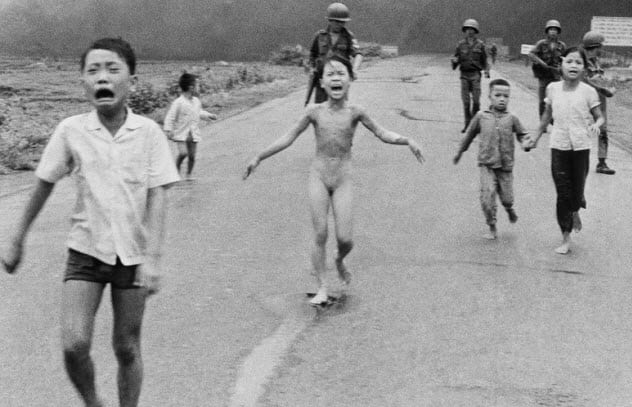
Napalm was used throughout the Vietnam War. Although intended to be a defoliant, it was often used against enemies and civilians alike. When such an event occurred on June 8, 1972, Huynh Cong Ut, professionally known as Nick Ut, was there to document one of the most harrowing stories of the war.
The picture was taken as a group of terrified children ran down Route 1 near Trang Bang village following a napalm attack against a suspected Vietcong safe haven. Featured prominently in the photograph is nine-year-old Kim Phuc whose nudity triggered Facebook’s content censor back in 2016.
Despite the eventual censorship from Facebook, The Terror of War was chosen for the 1973 Pulitzer Prize for Spot News Photography as well as the World Press Photo of the Year. Not only did Ut take the iconic photograph, but he also rushed the young girl to the hospital. There, she was saved despite having sustained burns to more than 30 percent of her body.[6]
4 Saigon Execution
1969
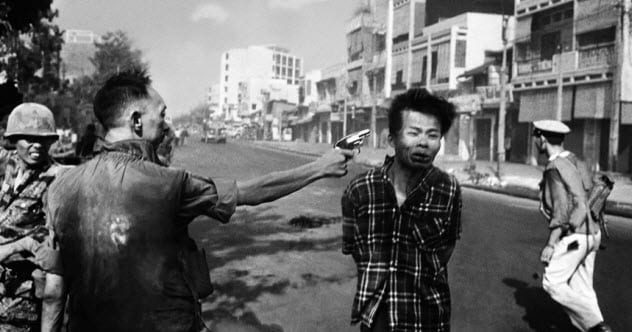
On February 1, 1968, South Vietnamese General Nguyen Ngoc Loan, who was the chief of the national police at the time, executed a Vietcong officer named Nguyen Van Lem. Loan carried out the execution on the streets of Saigon in plain view of anyone who happened to be watching. This included NBC’s television cameramen and Associated Press photographer Eddie Adams, who took this iconic photograph.
Immediately after shooting the man in the head, the general walked over to the reporters and plainly said, “These guys kill a lot of our people, and I think Buddha will forgive me.”
Adams’s photo immediately became a symbol of the brutality of the ongoing conflict. But there was far more going on before that image was taken than was widely known at the time.
The executed man was the leader of a “revenge squad” and had killed dozens of unarmed civilians earlier that day. Despite this, the imagery of his execution haunted Adams, who regretted taking the Pulitzer Prize–winning photograph. “The general killed the Vietcong; I killed the general with my camera.”[7]
3 Raising The Flag On Iwo Jima
1945
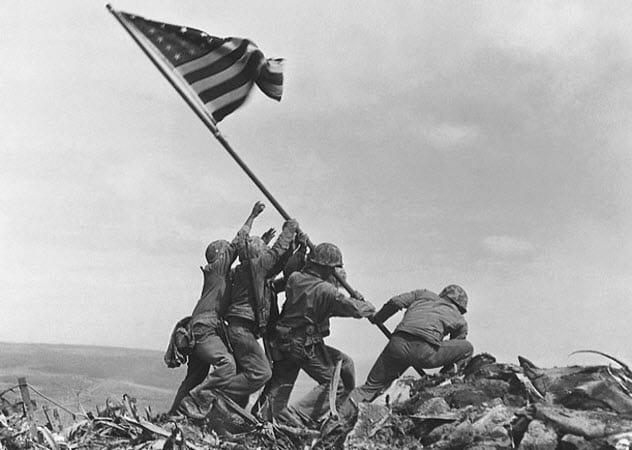
There are many photos of soldiers fighting in World War II. But the image that became the iconic representation of the American fighting spirit was taken by Joe Rosenthal at the top of Mount Suribachi on February 23, 1945.
The photograph was taken during the Battle of Iwo Jima about 90 minutes after a smaller flag was raised on the mountain. The image was so popular throughout the United States that it became synonymous with American pride and the Marine Corps’ fighting spirit.
A sculpture of the event was made into the Marine Corps War Memorial located in Arlington Ridge Park. Rosenthal took photographs throughout the war, but this image is his best known. He received little money for his work but has since been honored for his contributions.
Following his death, he was posthumously awarded the Department of the Navy Distinguished Public Service Award by the United States Marine Corps. Sig Gissler, an administrator for the Pulitzer Prizes for Columbia University, once said, “Of all the images that have captured Pulitzer Prizes, none is more memorable than Joe Rosenthal’s raising of the flag on Iwo Jima.”[8]
2 Victim Of The Oklahoma City Bombing
1996
The Oklahoma City bombing was the most devastating case of homegrown terrorism that the United States has ever seen. The bombing of the Alfred P. Murrah Federal Building in downtown Oklahoma City resulted in the deaths of 168 people.
This tragedy was particularly devastating due to the presence of a day care center in the building which had 15 of the 19 child victims of the attack. Though the bombing and its aftermath were well-documented at the time, the Pulitzer Prize–winning photograph by Charles Porter IV serves as a haunting reminder of the terror caused that day.
Taken on April 19, 1995, the photograph shows a fireman holding the body of a severely wounded infant in his hands. Porter was not a photographer covering the event but happened to have a camera on him.
He worked as a credit officer at Liberty Bank when the bombing occurred. As he was an aspiring journalist who was taught to “keep a loaded camera in my car at all times,” he was ready and able to snap the photograph that earned him the 1996 Pulitzer Prize in Spot News Photography.[9]
1 The Vulture And The Little Girl
1994
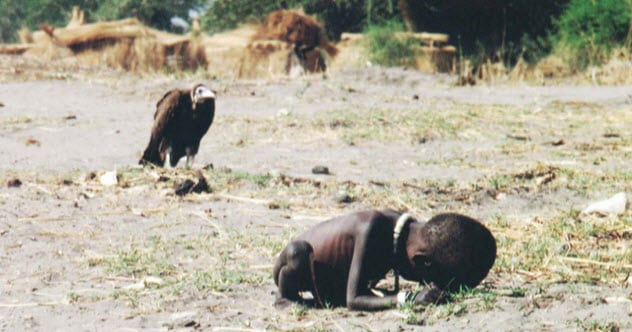
Of all the Pulitzer Prize–winning photographs, The Vulture and the Little Girl serves as the one with the most tragic story. Kevin Carter took this picture—which appeared in The New York Times on March 26, 1993—to document the situation going on in Sudan at that time.
The child, who is a boy but was believed to be a girl at the time, was struggling to reach a United Nations feeding center when he collapsed, weak from starvation. Carter took the picture of the emaciated toddler with a vulture standing nearby and received the Pulitzer Prize for Feature Photography in 1994.
The image immediately evoked harsh criticism of Carter, whom many condemned for taking a picture instead of helping the child. Four months after receiving the Pulitzer, Carter committed suicide. The psychological trauma he suffered from witnessing such hardship accompanied by the criticism he received for covering it pushed him to end his own life.
Bishop Desmond Tutu wrote of Carter’s suicide, “And we know a little about the cost of being traumatized that drove some to suicide, that, yes, these people were human beings operating under the most demanding of conditions.”[10]
Jonathan is a graphic artist, illustrator, and writer. He is a retired soldier and enjoys researching and writing about history, science, theology, and many other subjects.
Read more incredible stories behind prizewinning and poignant photographs on 10 Incredible Photographs That Won The Pulitzer Prize and 10 Poignant Photographs From Humanity’s Lowest Moments.




